More on this book
Community
Kindle Notes & Highlights
Read between
August 11 - August 24, 2018
BDNF might be an essential ingredient in combating anxiety, probably because it helps wire in positive memories that create a detour around the fear.
because the rapid, shallow breathing expels too much carbon dioxide, the blood’s pH level drops, triggering an alarm from the brain stem that causes muscles to constrict even more. (This is why breathing into a paper bag stops us from hyperventilating: it forces us to rebreathe the carbon dioxide.)
During a panic attack, there is a surge of corticotropin-releasing factor (CRF), which induces anxiety in its own right and also floods the nervous system with cortisol.
ANP directly dampens the sympathetic nervous system’s response by stemming the flow of epinephrine and lowering the heart rate, and it also seems to reduce the feeling of anxiousness, which is paramount.
Duke University took up the task in 1999. In a landmark study affectionately called SMILE
every fifty minutes of weekly exercise correlated to a 50 percent drop in the odds of being depressed.
James Blumenthal and his colleagues at Duke showed that exercise can stand in for Zoloft in treating depression.
“Exercise is directly antithetical to drug-addictive behavior. Because you need lung strength, muscle strength, mental acuity to engage in physical exercise—lots of things that drugs deprive you of.
nucleus accumbens, or reward center, and it has been the focus of addiction research ever since.
The routine and the physical activity gets the brain engaged and the mind moving in a direction other than toward the drug, reprogramming the basal ganglia to wire in an alternative reflexive behavior.
A groundbreaking study in 1990 revealed, for instance, that a lot of alcoholics have a gene variation (the D2R2 allele) that robs their reward center of dopamine receptors, lowering levels of the neurotransmitter.
neurotransmitters anandamide and 2-arachidonoylglycerol (2-AG). It turns out that marijuana, exercise, and chocolate all activate these same receptors in the brain. Both of these endocannabinoids are produced in the body and the brain when we exercise.
Exercise is the ultimate drug, right? What drug always works and doesn’t have any unhealthy side effects?”
cycle begins with signals from the hypothalamus that prompt the pituitary gland to secrete hormones called gonadotropins, which travel to the ovaries and trigger the mass production of estrogen and progesterone.
estrogen signals the production of brain-derived neurotrophic factor (BDNF), which in turn creates more serotonin.
explanation, certainly, is that physical activity increases levels of tryptophan in the bloodstream and thus concentrations of serotonin in the brain. It also balances dopamine, norepinephrine, and synaptic mediators such as BDNF. By stabilizing such a broad number of variables, exercise helps to tone down the ripple effects of shifting hormones.
Here’s how exercise keeps you going:
1. It strengthens the cardiovascular system. A strong heart and lungs reduce resting blood pressure. The result is less strain on the vessels in the body and the brain. There are a number of mechanisms at work here. First, contracting muscles during exercise releases growth factors such as VEGF and fibroblast growth factor (FGF-2). Aside from their role in helping neurons bind and promoting neurogenesis, they trigger a molecular chain reaction that produces endothelial cells, which make up the inner lining of blood vessels and thus are important for building new ones. These inroads expand the
...more
This highlight has been truncated due to consecutive passage length restrictions.
research consistently shows that the more fit you are, the more resilient your brain becomes and the better it functions both cognitively and psychologically.


